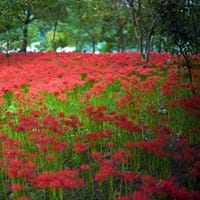Life Span
Perennial
Annual
Type
Herbs
Bulb or Corm or Tuber
Origin
Europe, Asia
China, Korea
Types
Not Available
Red Spider Lily, Magic Lily, Golden Spider Lily
Number of Varieties
Not Available
Habitat
Dry areas, Roadsides, stream banks, Stream side, Waste areas
Along cemeteries
USDA Hardiness Zone
3-7
5-10
Sunset Zone
1a, 1b, 2a, 2b, 3a, 3b, 4, 5, 6, 7, 8, 9, 10, 11, 12, 13, 14, 15, 16, 17, 18, 19, 20, 21, 22, 23, 24
21,22
Habit
Clump-Forming
Clump-Forming
Flower Color
White, Lavender
Yellow, Orange, Gold
Flower Color Modifier
Bicolor
Bicolor
Fruit Color
Sandy Brown
Not Available
Leaf Color in Spring
Gray Green, Gray
Green, Dark Green
Leaf Color in Summer
Gray Green, Gray
Light Green
Leaf Color in Fall
Gray Green, Gray
Several shades of Green
Leaf Color in Winter
Light Green
Light Green
Leaf Shape
Arrowhead
Linear
Plant Season
Spring, Summer, Fall
Summer, Fall
Sunlight
Full Sun, Partial Sun
Full Sun, Partial Sun
Type of Soil
Clay, Loam, Sand
Clay, Loam, Sand
The pH of Soil
Acidic, Neutral, Alkaline
Acidic, Neutral
Soil Drainage
Well drained
Well drained
Bloom Time
Summer, Late Summer, Early Fall
Late Summer, Early Fall
Tolerances
Drought, Dry soil
Drought
Where to Plant?
Container, Ground
Ground
How to Plant?
Seedlings
From bulbs
Plant Maintenance
Low
Medium
Watering Requirements
Do Not over Water, Never Over-water, Requires regular watering, Water when soil is dry
Water daily during growing season, water on alternate days
In Summer
Lots of watering
Lots of watering
In Spring
Moderate
Moderate
In Winter
Average Water
Average Water
Soil pH
Acidic, Neutral, Alkaline
Acidic, Neutral
Soil Type
Clay, Loam, Sand
Clay, Loam, Sand
Soil Drainage Capacity
Well drained
Well drained
Sun Exposure
Full Sun, Partial Sun
Full Sun, Partial Sun
Pruning
Prune if you want to improve plant shape, Prune in spring, Remove damaged leaves, Remove dead leaves
Remove damaged leaves, Remove dead branches, Remove dead leaves
Fertilizers
fertilize every 2-3 weeks while growing, fertilize in growing season
All-Purpose Liquid Fertilizer
Pests and Diseases
Caterpillars, Leaf Hoppers, Nematodes, Spider mites
Red blotch
Plant Tolerance
Drought, Frost
Drought
Flower Petal Number
Single
Single
Fragrant Bark/Stem
Yes
No
Foliage Texture
Medium
Medium
Foliage Sheen
Matte
Matte
Attracts
Flying insects, Insects, Spider Mites
Bees, Butterflies, Hummingbirds
Allergy
Avoid during Pregnancy, Headache, Stomach pain, Vomiting
drowsiness, Vomiting
Aesthetic Uses
Beautification, Landscape Designing, Showy Purposes
Landscape Designing
Beauty Benefits
Not Available
Not Available
Edible Uses
Yes
Sometimes
Environmental Uses
Air purification
Air purification
Medicinal Uses
Arthritis, Cold, constipation, Fever, Insomia, Migraines, Upset stomach
anti-cancer, treating poison ivy, treating tumours
Part of Plant Used
Whole plant
Bulbs
Other Uses
Air freshner, Decoration Purposes, Employed in herbal medicine, Making Perfumes, Making Shampoo, Making Sweet Scented Oil, Medicinal oil, Used as Ornamental plant, Used for its medicinal properties
Leaves are used as mosquito repellent, Used for its medicinal properties
Used As Indoor Plant
Yes
No
Used As Outdoor Plant
Yes
Yes
Garden Design
Container, Herb / Vegetable, Mixed Border
Container, Cutflower, Feature Plant, Mixed Border, Rock Garden / Wall
Botanical Name
NEPETA cataria
LYCORIS chinensis
Common Name
Cat Nip, Catnip
Golden Surprise Lily, Spiderlily
In Hindi
कटनीप
Lycoris Spider lily
In German
Katzenminze
Spinnenlilien
In French
cataire
Lycoris Spider lily
In Spanish
Catnip
Lycoris Spider lily
In Greek
Είδος δυόσμου
Lycoris Spider lily
In Portuguese
catnip
Lycoris Spider lily
In Polish
Kocimiętka
Lycoris Spider lily
In Latin
catnip
Lycoris Spider lily
Phylum
Magnoliophyta
Angiosperms
Class
Magnoliopsida
Lilopsida
Family
Lamiaceae
Amaryllidaceae
Clade
Angiosperms, Asterids, Eudicots
Angiosperms, Monocots
Tribe
Mentheae
Not Available
Subfamily
Nepetoideae
Amaryllidoideae
Number of Species
Not Available
Properties of Catnip and Spider lily
Wondering what are the properties of Catnip and Spider lily? We provide you with everything About Catnip and Spider lily. Catnip doesn't have thorns and Spider lily doesn't have thorns. Also Catnip does not have fragrant flowers. Catnip has allergic reactions like Avoid during Pregnancy, Headache, Stomach pain and Vomiting and Spider lily has allergic reactions like Avoid during Pregnancy, Headache, Stomach pain and Vomiting. Compare all the properties and characteristics of these two plants. Find out which of these plant can be used as indoor plant. If you are interested to decorate your house and garden, find out aesthetic uses, compare them and select the plant which will beautify your surrounding. Along with beautification, try comparing medicinal and edible uses of Catnip and Spider lily and you can choose the plant having best and most benefits.
Season and Care of Catnip and Spider lily
Season and care of Catnip and Spider lily is important to know. While considering everything about Catnip and Spider lily Care, growing season is an essential factor. Catnip season is Spring, Summer and Fall and Spider lily season is Spring, Summer and Fall. The type of soil for Catnip is Clay, Loam, Sand and for Spider lily is Clay, Loam, Sand while the PH of soil for Catnip is Acidic, Neutral, Alkaline and for Spider lily is Acidic, Neutral.
Catnip and Spider lily Physical Information
Catnip and Spider lily physical information is very important for comparison. Catnip height is 980.00 cm and width 60.00 cm whereas Spider lily height is 50.80 cm and width 22.90 cm. The color specification of Catnip and Spider lily are as follows:
Catnip flower color: White and Lavender
Catnip leaf color: Gray Green and Gray
Spider lily flower color: Yellow, Orange and Gold
- Spider lily leaf color: Green and Dark Green
Care of Catnip and Spider lily
Care of Catnip and Spider lily include pruning, fertilizers, watering etc. Catnip pruning is done Prune if you want to improve plant shape, Prune in spring, Remove damaged leaves and Remove dead leaves and Spider lily pruning is done Remove damaged leaves, Remove dead branches and Remove dead leaves. In summer Catnip needs Lots of watering and in winter, it needs Average Water. Whereas, in summer Spider lily needs Lots of watering and in winter, it needs Average Water.





